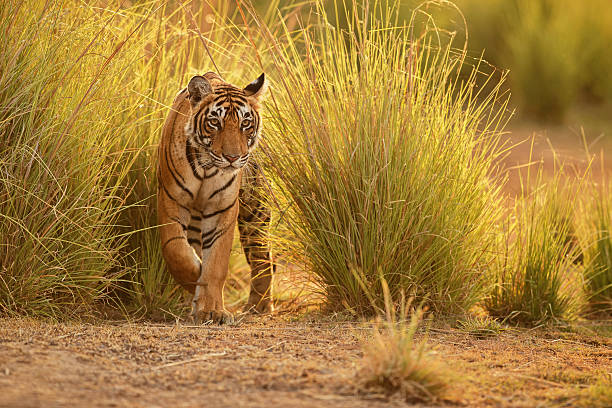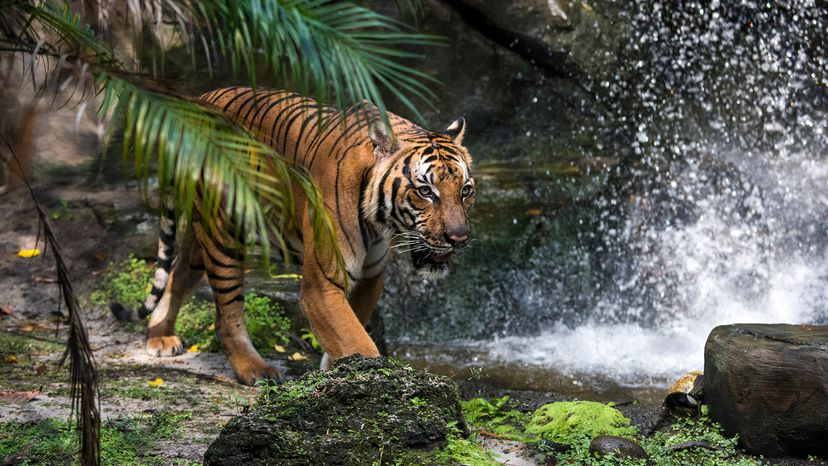A tiger is a large, powerful carnivorous cat, famous for its bold orange fur with black stripes. Tigers are the largest species of big cats, with some males reaching up to 10 feet in length (including their tail) and weighing up to 600 pounds. Their coat not only makes them one of the most beautiful animals in the world, but it also helps them blend into their natural environments, like dense forests and grasslands.
Tigers are apex predators, meaning they sit at the top of the food chain. They are skilled hunters and mostly hunt alone. Their diet mainly consists of large prey, like deer, wild boar, and sometimes even smaller animals like monkeys or birds. Tigers are stealthy and patient, often stalking their prey for long periods before making a quick, powerful charge to catch it.
Scientific Classification
-
Kingdom: Animalia
-
Phylum: Chordata
-
Class: Mammalia
-
Order: Carnivora
-
Family: Felidae
-
Genus & Species: Panthera tigris
There are several subspecies of tiger, including:
-
Bengal Tiger (Panthera tigris tigris)
-
Siberian Tiger (Panthera tigris altaica)
-
Indochinese Tiger (Panthera tigris corbetti)
-
Malayan Tiger, South China Tiger, and Sumatran Tiger
Common Names
-
Tiger (general name)
-
In Hindi: Sher
-
In Yoruba: Ekun
-
In Igbo: Agụ ọhịa nwere akara (“Marked forest lion”)
-
In many Asian cultures, tigers are seen as guardians and protectors
Geographic Distribution
Tigers are native to Asia and once roamed from Turkey to eastern Russia. Today, they are found in:
-
India
-
Nepal
-
Bangladesh
-
Bhutan
-
Russia (Siberia)
-
Indonesia (Sumatra)
-
Parts of Southeast Asia
They live in forests, grasslands, mangroves, and even snowy mountains.
Physical Characteristics
Tigers are the largest cats in the world, built for strength, stealth, and hunting:
-
Coat: Orange with black stripes (each tiger’s stripes are unique!)
-
Eyes: Round with excellent night vision
-
Claws & Teeth: Sharp and powerful for gripping and biting
-
Body: Muscular with a long tail for balance
-
Roar: Can be heard up to 3 km away!
 Image showing a Bengal tiger walking through tall grass (Source: iStock)
Image showing a Bengal tiger walking through tall grass (Source: iStock)
Major species of Tigers
1. Bengal Tiger (Panthera tigris tigris)
Most common tiger, found mainly in India and Bangladesh.
-
Color: Bright orange with bold black stripes
-
Size: Large, up to 3 meters long
-
Diet: Deer, wild pigs, buffalo
-
Habitat: Forests and grasslands
 Image showing a Bengal tiger resting on a rock (Source: Pexels)
Image showing a Bengal tiger resting on a rock (Source: Pexels)
2. Siberian Tiger (Panthera tigris altaica)
This is the largest tiger species, also called the Amur Tiger.
-
Color: Pale orange with lighter stripes
-
Fur: Thicker for cold weather
-
Habitat: Snowy forests in eastern Russia
-
Threats: Poaching and deforestation
 Image showing siberian tigers in snow-covered woods (Source: Global Times)
Image showing siberian tigers in snow-covered woods (Source: Global Times)
3. Indochinese Tiger (Panthera tigris corbetti)
This shy and secretive tiger lives in the forests of Southeast Asia, including Thailand, Myanmar, Laos, Cambodia, and Vietnam.
-
Size: Slightly smaller than Bengal tigers
-
Color: Dark orange coat with narrow black stripes
-
Habitat: Dense tropical forests and hilly regions
-
Diet: Wild boar, deer, and smaller animals
-
Status: Endangered, with fewer than 400 believed to be left in the wild
These tigers are rarely seen due to their elusive nature and the thick forests they live in. Sadly, they are at high risk from poaching and habitat destruction.
 Image showing an Indochinese tiger walking through dense bamboo forest (Source: Motion Array)
Image showing an Indochinese tiger walking through dense bamboo forest (Source: Motion Array)
4. Malayan Tiger (Panthera tigris jacksoni)
Found only in Peninsular Malaysia, this tiger is critically endangered and a national symbol of Malaysia, even appearing on the country’s coat of arms.
-
Size: One of the smallest tiger subspecies
-
Color: Deep orange with distinct, closely spaced stripes
-
Habitat: Rainforests and lowland forests
-
Diet: Sambar deer, wild pigs, and smaller animals
-
Status: Critically endangered, fewer than 150 individuals are estimated to remain in the wild
Malayan tigers are under severe threat from illegal logging, poaching, and loss of prey. Conservation groups in Malaysia are working hard to save this beautiful big cat through anti-poaching patrols, protected areas, and public education.

Fun facts about Tigers
-
Tigers can swim and actually enjoy water.
-
Their roar is so powerful it can paralyze prey.
-
A tiger’s paw print is called a pugmark.
-
Tigers mark territory with scent and scratch marks.
-
They usually hunt alone, not in groups like lions.
Importance to nature & humans
-
Tigers help control prey animal populations (like deer), keeping ecosystems balanced.
-
They are cultural icons in Asia, symbolizing courage, royalty, and protection.
-
Ecotourism centered on tigers supports local communities and conservation.
-
In traditional medicine (though discouraged today), tiger parts were wrongly believed to have healing powers.
Health & common issues
In the wild, tigers face many threats:
-
Poaching for skin, teeth, and bones
-
Habitat loss due to farming, logging, and human development
-
Conflict with humans when tigers enter villages or farms
-
Inbreeding in small populations, reducing genetic strength
Conservation Status
Tigers are classified as Endangered by the IUCN. Some subspecies, like the South China tiger, are critically endangered or even possibly extinct in the wild.
What helps tigers survive?
-
Protected areas like national parks and reserves
-
Anti-poaching laws and patrols
-
Wildlife corridors to connect habitats
-
Community education and awareness
Tiger vs Lion
| Feature | Tiger | Lion |
|---|---|---|
| Habitat | Forests, grasslands | Savannas, plains |
| Grouping | Solitary | Lives in groups (prides) |
| Size | Larger, longer body | Slightly smaller |
| Roar | Deep and long | Loud and short bursts |
| Mane | No (except rare males) | Yes (on males) |
If you are curious to know more about Tigers or other animals, feel free to reach out to us at Doctor Hulk Veterinary Hospital, or simply call 08143397614.



















Reviews
There are no reviews yet.